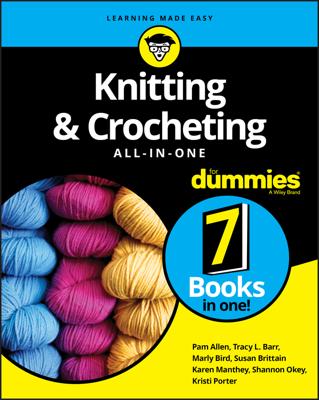Needles generally fit into a few basic categories; here are the characteristics of each:
- Straight needles: Classic knitting needles are straight needles, which are about 14 inches long and made of metal or wood. They have a point on one end and a stopper of some sort on the opposite end to keep the stitches from falling off. You can knit almost anything on these, except for those projects that were designed to be knit in the round or something extremely wide, such as a blanket. You can get shorter 10-inch needles, too, which are a bit more manageable for something like a scarf. These shorter needles are also easier to tuck into your bag.
- Circular needles: These needles have two pointy ends connected by a cable. They come in different lengths as well as different gauges. The length of a circular needle is measured from tip to tip. A pattern will specify which length you need for your project. For instance, to knit a hat, you need a short length, like 16 inches. A sweater, on the other hand, knits up on a needle that's 24 or 36 inches long. If you're knitting something with a huge number of stitches (like a blanket), you may need an even longer needle.
- Note that you can use circular needles even if you aren't knitting in the round. Just like you do with straight needles, turn the work around at the end of the row and switch the needle tips to the opposite hands. Think of your circular needle as two straight needles that happen to be stuck together. Some knitters prefer circular needles for all their projects because it's more difficult to lose a needle and because it keeps the weight of the knitting more centered in your lap. If you have trouble with repetitive stress injuries, circular needles may lessen the strain on your wrists.
- Double-pointed needles: Double-pointed needles are used less often than straight and circular needles, unless you make a lot of socks. Double-pointed needles look like large toothpicks and come in sets of four or five. These needles are used to knit in the round to create tubes that are smaller than you can make on a single circular needle, mainly socks and the tops of hats.
- Cable needles: Cable needles come in a few different varieties. Some are shaped like U's or J's; others are like short double-pointed needles with a narrow or bent spot in the center. One sort doesn't work better than another, so if you're having trouble with the one you've got, experiment a little with a different type.

